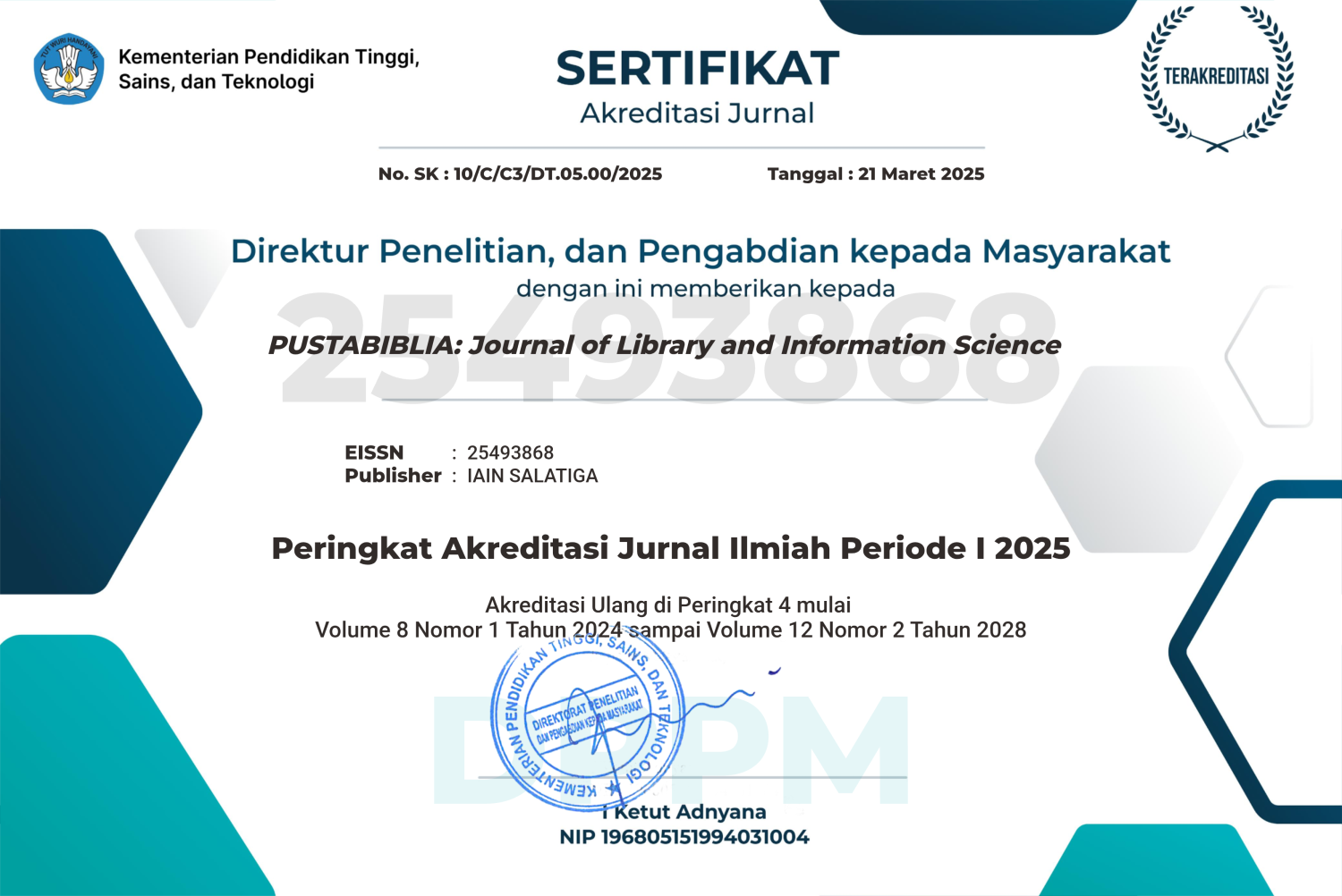Analisis penggunaan e-resources perpustakaan oleh mahasiswa FEBI UIN Salatiga: pendekatan Technology Acceptance Model
DOI:
https://doi.org/10.18326/pustabiblia.v9i1.574Keywords:
E-Resources, UIN Salatiga library, TAM, SEM-PLSAbstract
This study aims to determine what factors influence the use of UIN Salatiga library e-resources using the TAM (Technology Acceptance Model) model. The sample used in this research is active students of the Faculty of Economics and Islamic Business (FEBI) UIN Salatiga. The method used in this research is the Structural Equation Model-Partial Least Square (SEM-PLS). The results showed that all variables in the TAM model can significantly explain the use of UIN Salatiga library e-resources. However, information literacy does not have a significant effect on the perceived usefulness and usage of UIN Salatiga library e-resources. The results of this study provide useful information, especially for the management of UIN Salatiga Library to continue to socialize regularly with students regarding the services owned by the library, including e-resources, in order to encourage students to be able to use these services to obtain quality reference sources.
References
Agung, Anak Agung Putu. 2012. Metodologi Penelitian Bisnis. Malang: UB Press.
Ahmed, Yunis Ali, Mohammad Nazir Ahmad, Norasnita Ahmad, and Nor Hidayati Zakaria. 2019. “Social Media for Knowledge-Sharing: A Systematic Literature Review.” Telematics and Informatics 37 (April): 72–112. https://doi.org/10.1016/j.tele.2018.01.015.
APJII. 2022. “Profil Internet Indonesia 2022.” https://apjii.or.id/.
Chen, Yu-Hui. 2011. “Undergraduates’ Perceptions and Use of the University Libraries Web Portal: Can Information Literacy Instruction Make a Difference?” In Proceedings of the American Society for Information Science and Technology, 48:1–10. https://doi.org/10.1002/meet.2011.14504801051.
Chin, Wynne W. 2010. How to Write Up and Report PLS Analyses. Edited by Vincenzo Esposito Vinzi, Wynne W. Chin, Jörg Henseler, and Huiwen Wang. Handbook of Partial Least Squares. Berlin, Heidelberg: Springer Berlin Heidelberg. https://doi.org/10.1007/978-3-540-32827-8.
Davis, Fred D., Richard P. Bagozzi, and Paul R. Warshaw. 1989. “User Acceptance of Computer Technology: A Comparison of Two Theoretical Models.” Management Science 35 (8): 982–1003. https://doi.org/10.1287/mnsc.35.8.982.
Ghozali, Imam, and Hengky Latan. 2015. Partial Least Squares: Konsep, Teknik Dan Aplikasi Menggunakan Program SmartPLS 3.0. 2nd ed. Semarang: Badan Penerbit-Undip.
Hair, Joseph F, G. Tomas M. Hult, Christian M. Ringle, and Marko Sarstedt. 2017. A Primer on Partial Least Squares Structural Equation Modeling (PLS-SEM). Thousand Oaks, California: SAGE Publications Inc.
Hair, Joseph F, Lucy M. Matthews, Ryan L. Matthews, and Marko Sarstedt. 2017. “PLS-SEM or CB-SEM: Updated Guidelines on Which Method to Use.” International Journal of Multivariate Data Analysis 1 (2): 107–23. https://doi.org/10.1504/IJMDA.2017.087624.
Holden, Richard J., and Ben-Tzion Karsh. 2010. “The Technology Acceptance Model: Its Past and Its Future in Health Care.” Journal of Biomedical Informatics 43 (1): 159–72. https://doi.org/10.1016/j.jbi.2009.07.002.
Hu, Jiming, and Yin Zhang. 2016. “Chinese Students’ Behavior Intention to Use Mobile Library Apps and Effects of Education Level and Discipline.” Library Hi Tech 34 (4): 639–56. https://doi.org/10.1108/LHT-06-2016-0061.
Isibika, Irene Shubi, and George Firmin Kavishe. 2018. “Utilisation of Subscribed Electronic Resources by Library Users in Mzumbe University Library, Tanzania.” Global Knowledge, Memory and Communication 67 (1/2): 109–25. https://doi.org/10.1108/GKMC-09-2017-0075.
Itmamudin, Itmamudin. 2020. “Analisis Pemanfaatan E-Resources Oleh Mahasiswa Pascasarjana IAIN Salatiga.” Pustabiblia: Journal of Library and Information Science 4 (2): 307–24. https://doi.org/10.18326/pustabiblia.v4i2.307-324.
Jeong, Hanho. 2011. “An Investigation of User Perceptions and Behavioral Intentions towards the E-Library.” Library Collections, Acquisitions, and Technical Services 35 (2–3): 45–60. https://doi.org/10.1016/j.lcats.2011.03.018.
Johnston, Bill, and Sheila Webber. 2003. “Information Literacy in Higher Education: A Review and Case Study.” Studies in Higher Education 28 (3): 335–52. https://doi.org/10.1080/03075070309295.
Joo, Soohyung, and Namjoo Choi. 2015. “Factors Affecting Undergraduates’ Selection of Online Library Resources in Academic Tasks.” Library Hi Tech 33 (2): 272–91. https://doi.org/10.1108/LHT-01-2015-0008.
Letchumanan, Malathi, and Balakrishnan Muniandy. 2013. “Migrating to E‐book: A Study on Perceived Usefulness and Ease of Use.” Library Hi Tech News 30 (7): 10–15. https://doi.org/10.1108/LHTN-05-2013-0028.
Mack, Natasha, Cynthia Woodsong, Kathleen M. MacQueen, Greg Guest, and Emily Namey. 2005. Qualitative Research Methods: A Data Collector’s Field Guide. North Carolina: Family Health International.
Makmur, Testiani. 2015. Perpustakaan Era Keterbukaan Informasi Publik. Yogyakarta: Graha Ilmu.
Marangunić, Nikola, and Andrina Granić. 2015. “Technology Acceptance Model: A Literature Review from 1986 to 2013.” Universal Access in the Information Society 14 (1): 81–95. https://doi.org/10.1007/s10209-014-0348-1.
Matheus, Elizabeth, and Ruth Abankwah. 2018. “Learners’ Perceptions on Online Library Resources at Namibian College of Open Learning.” Information and Learning Science 119 (9/10): 597–606. https://doi.org/10.1108/ILS-11-2017-0126.
Nikou, Shahrokh, Mark De Reuver, and Matin Mahboob Kanafi. 2022. “Workplace Literacy Skills—How Information and Digital Literacy Affect Adoption of Digital Technology.” Journal of Documentation 78 (7): 371–91. https://doi.org/10.1108/JD-12-2021-0241.
Nurrizqi, Ade Dwi, and Rhoni Rodin. 2020. “Tingkat Literasi Digital Mahasiswa Jurusan Ilmu Perpustakaan Dalam Pemanfaatan E-Resources UIN Raden Fatah Palembang.” Pustakaloka 12 (1): 72–89. https://doi.org/10.21154/pustakaloka.v12i1.1935.
Peng, David Xiaosong, and Fujun Lai. 2012. “Using Partial Least Squares in Operations Management Research: A Practical Guideline and Summary of Past Research.” Journal of Operations Management 30 (6): 467–80. https://doi.org/10.1016/j.jom.2012.06.002.
Pinigas, Mbengo, Ruzande Cleopas, and Maxwell A. Phiri. 2018. “Acceptance of E-Resources by Students in Zimbabwe State Universities’ Libraries: A Consumer Behavior Perspective.” International Information & Library Review 50 (3): 181–93. https://doi.org/10.1080/10572317.2017.1387443.
Priadana, Moh. Sidik, and Saludin Muis. 2016. Metodologi Penelitian Ekonomi Dan Bisnis. 2nd ed. Yogyakarta: Ekuilibria.
Rafique, Hamaad, Alaa Omran Almagrabi, Azra Shamim, Fozia Anwar, and Ali Kashif Bashir. 2020. “Investigating the Acceptance of Mobile Library Applications with an Extended Technology Acceptance Model (TAM).” Computers & Education 145 (February): 103732. https://doi.org/10.1016/j.compedu.2019.103732.
Rahmi, Lailatur. 2021. “Penggunaan E-Resources Oleh Mahasiswa Ilmu Perpustakaan Selama Pandemi Covid 19.” Al-Ma’arif: Jurnal Ilmu Perpustakaan Dan Informasi Islam 1 (1): 36–47.
Rezvani, Shahla, Shahin Heidari, Nasim Roustapisheh, and Saeid Dokhanian. 2022. “The Effectiveness of System Quality, Habit, and Effort Expectation on Library Application Use Intention: The Mediating Role of Perceived Usefulness, Perceived Ease of Use, and User Satisfaction.” International Journal of Business Information Systems 1 (1): 1–18. https://doi.org/10.1504/IJBIS.2022.10049515.
Rizun, Mariia, and Artur Strzelecki. 2020. “Students’ Acceptance of the COVID-19 Impact on Shifting Higher Education to Distance Learning in Poland.” International Journal of Environmental Research and Public Health 17 (18): 6468. https://doi.org/10.3390/ijerph17186468.
Susanti, Anastasia Tri. 2011. “Pemanfaatan Jurnal Elektronik Di Perpustakaan Universitas Atma Jaya Yogyakarta.” Berkala Ilmu Perpustakaan Dan Informasi 7 (1): 18–24. https://doi.org/10.22146/bip.8817.
Unal, Erhan, and Ahmet Murat Uzun. 2021. “Understanding University Students’ Behavioral Intention to Use Edmodo through the Lens of an Extended Technology Acceptance Model.” British Journal of Educational Technology 52 (2): 619–37. https://doi.org/10.1111/bjet.13046.
Uska, Muhammad Zamroni. 2017. “Analisis Penerimaan Digital Library Menggunakan Technology Acceptance Model (TAM) Di Universitas Hamzanwadi.” Edumatic: Jurnal Pendidikan Informatika 1 (1): 1–10. https://doi.org/10.29408/edumatic.v1i1.723.
Wallace, Linda G., and Steven D. Sheetz. 2014. “The Adoption of Software Measures: A Technology Acceptance Model (TAM) Perspective.” Information & Management 51 (2): 249–59. https://doi.org/10.1016/j.im.2013.12.003.
Yoon, Hye-Young. 2016. “User Acceptance of Mobile Library Applications in Academic Libraries: An Application of the Technology Acceptance Model.” The Journal of Academic Librarianship 42 (6): 687–93. https://doi.org/10.1016/j.acalib.2016.08.003.
Yu, Kaijun, and Gang Huang. 2020. “Exploring Consumers’ Intent to Use Smart Libraries with Technology Acceptance Model.” The Electronic Library 38 (3): 447–61. https://doi.org/10.1108/EL-08-2019-0188.
Yu, Liqin, Di Wu, Harrison Hao Yang, and Sha Zhu. 2022. “Smart Classroom Preferences and Information Literacy among College Students.” Australasian Journal of Educational Technology 38 (2): 142–61. https://doi.org/10.14742/ajet.7081.
Downloads
Published
Issue
Section
License
Copyright (c) 2025 M. Muqtafin

This work is licensed under a Creative Commons Attribution-ShareAlike 4.0 International License.
Copyright
Authors retain copyright and grant the journal right of first publication with the work simultaneously licensed under a Creative Commons Attribution-ShareAlike 4.0 International License. In line with the license, authors are allowed to share and adapt the material. In addition, the material must be given appropriate credit, provided with a link to the license, and indicated if changes were made. If authors remix, transform or build upon the material, authors must distribute their contributions under the same license as the original.
Licensing

This work is licensed under a Creative Commons Attribution-ShareAlike 4.0 International License.







